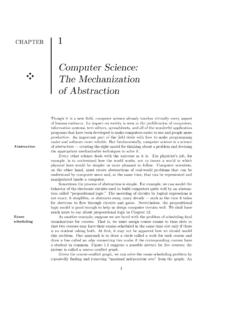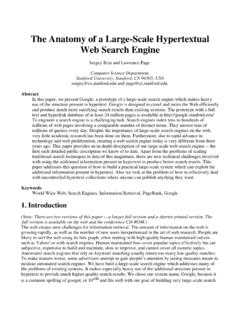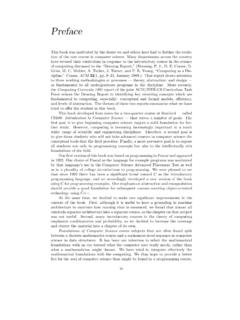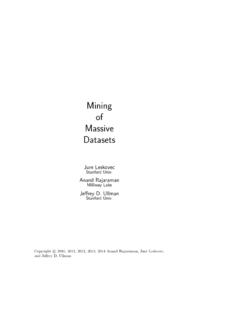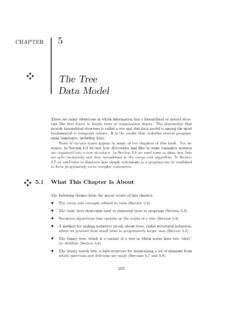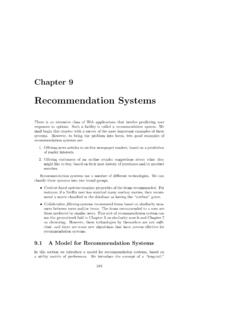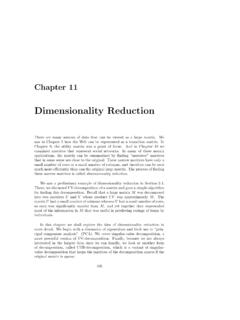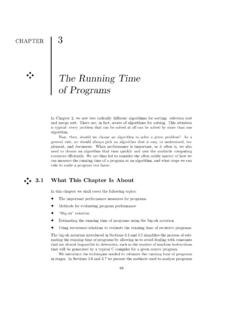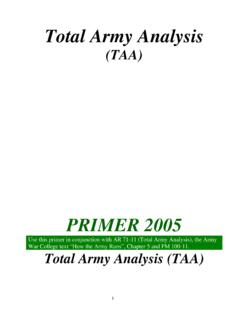Transcription of The Relational Data Model - The Stanford University InfoLab
1 CHAPTER 8.. The Relational Data Model One of the most important applications for computers is storing and managing information. The manner in which information is organized can have a profound effect on how easy it is to access and manage. Perhaps the simplest but most versatile way to organize information is to store it in tables. The Relational Model is centered on this idea: the organization of data into collections of two-dimensional tables called relations. We can also think of the Relational Model as a generalization of the set data Model that we discussed in Chapter 7, extending binary relations to relations of arbitrary arity. Originally, the Relational data Model was developed for databases that is, Database information stored over a long period of time in a computer system and for database management systems, the software that allows people to store, access, and modify this information.
2 Databases still provide us with important motivation for understanding the Relational data Model . They are found today not only in their original, large-scale applications such as airline reservation systems or banking sys- tems, but in desktop computers handling individual activities such as maintaining expense records, homework grades, and many other uses. Other kinds of software besides database systems can make good use of tables of information as well, and the Relational data Model helps us design these tables and develop the data structures that we need to access them efficiently. For example, such tables are used by compilers to store information about the variables used in the program, keeping track of their data type and of the functions for which they are defined.. What This Chapter Is About There are three intertwined themes in this chapter. First, we introduce you to the design of information structures using the Relational Model .
3 We shall see that Tables of information, called relations, are a powerful and flexible way to represent information (Section ). 403. 404 THE Relational DATA Model . An important part of the design process is selecting attributes, or properties of the described objects, that can be kept together in a table, without introduc- ing redundancy, a situation where a fact is repeated several times (Section ). The columns of a table are named by attributes. The key for a table (or relation) is a set of attributes whose values uniquely determine the values of a whole row of the table. Knowing the key for a table helps us design data structures for the table (Section ). Indexes are data structures that help us retrieve or change information in tables quickly. Judicious selection of indexes is essential if we want to operate on our tables efficiently (Sections , , and ). The second theme is the way data structures can speed access to information.
4 We shall learn that Primary index structures, such as hash tables, arrange the various rows of a table in the memory of a computer. The right structure can enhance efficiency for many operations (Section ). Secondary indexes provide additional structure and help perform other opera- tions efficiently (Sections and ). Our third theme is a very high-level way of expressing queries, that is, questions about the information in a collection of tables. The following points are made: Relational algebra is a powerful notation for expressing queries without giving details about how the operations are to be carried out (Section ). The operators of Relational algebra can be implemented using the data struc- tures discussed in this chapter (Section ). In order that we may get answers quickly to queries expressed in Relational algebra, it is often necessary to optimize them, that is, to use algebraic laws to convert an expression into an equivalent expression with a faster evaluation strategy.
5 We learn some of the techniques in Section .. Relations Section introduced the notion of a relation as a set of tuples. Each tuple of a relation is a list of components, and each relation has a fixed arity, which is the number of components each of its tuples has. While we studied primarily binary relations, that is, relations of arity 2, we indicated that relations of other arities were possible, and indeed can be quite useful. The Relational Model uses a notion of relation that is closely related to this set-theoretic definition, but differs in some details. In the Relational Model , in- formation is stored in tables such as the one shown in Fig. This particular table represents data that might be stored in a registrar's computer about courses, students who have taken them, and the grades they obtained. Attribute The columns of the table are given names, called attributes.
6 In Fig. , the attributes are Course, StudentId, and Grade. SEC. RELATIONS 405. Course StudentId Grade CS101 12345 A. CS101 67890 B. EE200 12345 C. EE200 22222 B+. CS101 33333 A . PH100 67890 C+. Fig. A table of information. Relations as Sets Versus Relations as Tables In the Relational Model , as in our discussion of set-theoretic relations in Section , a relation is a set of tuples. Thus the order in which the rows of a table are listed has no significance, and we can rearrange the rows in any way without changing the value of the table, just as we can we rearrange the order of elements in a set without changing the value of the set. The order of the components in each row of a table is significant, since different columns are named differently, and each component must represent an item of the kind indicated by the header of its column. In the Relational Model , however, we may permute the order of the columns along with the names of their headers and keep the relation the same.
7 This aspect of database relations is different from set- theoretic relations, but rarely shall we reorder the columns of a table, and so we can keep the same terminology. In cases of doubt, the term relation in this chapter will always have the database meaning. Tuple Each row in the table is called a tuple and represents a basic fact. The first row, (CS101, 12345, A), represents the fact that the student with ID number 12345. got an A in the course CS101. A table has two aspects: 1. The set of column names, and 2. The rows containing the information. The term relation refers to the latter, that is, the set of rows. Each row represents a tuple of the relation, and the order in which the rows appear in the table is immaterial. No two rows of the same table may have identical values in all columns. Relation scheme Item (1), the set of column names (attributes) is called the scheme of the relation.
8 The order in which the attributes appear in the scheme is immaterial, but we need to know the correspondence between the attributes and the columns of the table in order to write the tuples properly. Frequently, we shall use the scheme as the name of the relation. Thus the table in Fig. will often be called the Course-StudentId-Grade relation. Alternatively, we could give the relation a name, like CSG. 406 THE Relational DATA Model . Representing Relations As sets, there are a variety of ways to represent relations by data structures. A. table looks as though its rows should be structures, with fields corresponding to the column names. For example, the tuples in the relation of Fig. could be represented by structures of the type struct CSG {. char Course[5];. int StudentId;. char Grade[2];. };. The table itself could be represented in any of a number of ways, such as 1. An array of structures of this type.
9 2. A linked list of structures of this type, with the addition of a next field to link the cells of the list. Additionally, we can identify one or more attributes as the domain of the relation and regard the remainder of the attributes as the range. For instance, the relation of Fig. could be viewed as a relation from domain Course to a range consisting of StudentId-Grade pairs. We could then store the relation in a hash table according to the scheme for binary relations that we discussed in Section That is, we hash Course values, and the elements in buckets are Course-StudentId-Grade triples. We shall take up this issue of data structures for relations in more detail, starting in Section Databases A collection of relations is called a database. The first thing we need to do when designing a database for some application is to decide on how the information to be stored should be arranged into tables.
10 Design of a database, like all design problems, is a matter of business needs and judgment. In an example to follow, we shall expand our application of a registrar's database involving courses, and thereby expose some of the principles of good database design. Some of the most powerful operations on a database involve the use of several relations to represent coordinated types of data. By setting up appropriate data structures, we can jump from one relation to another efficiently, and thus obtain information from the database that we could not uncover from a single relation. The data structures and algorithms involved in navigating among relations will be discussed in Sections and The set of schemes for the various relations in a database is called the scheme Database of the database. Notice the difference between the scheme for the database, which scheme tells us something about how information is organized in the database, and the set of tuples in each relation, which is the actual information stored in the database.


